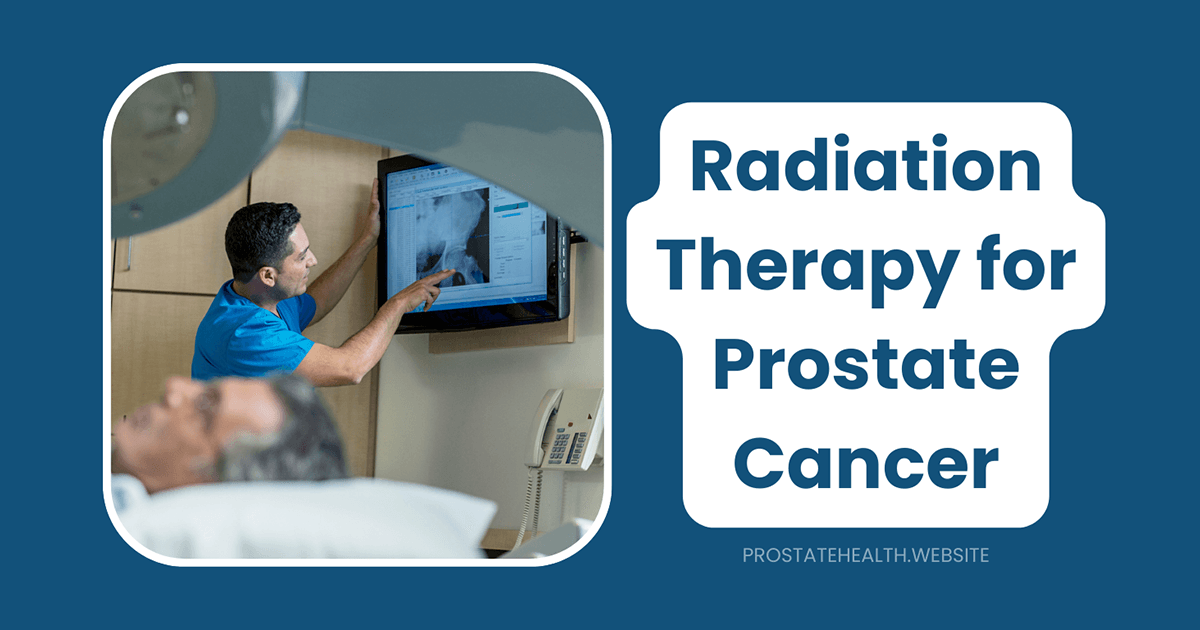Radiation Therapy Options for Prostate Cancer: External Beam vs. Brachytherapy

When facing a prostate cancer diagnosis, the array of treatment options can feel overwhelming. For many men with localized prostate cancer, radiation therapy represents an effective, non-surgical approach with excellent cancer control rates. However, not all radiation treatments are the same, and understanding the differences between external beam radiation therapy (EBRT) and brachytherapy can help you make an informed decision that aligns with your specific situation and preferences.
As someone who has spent years advocating for men’s prostate health, I’ve seen how critical it is for patients to understand their treatment options. In this comprehensive guide, we’ll explore the two main types of radiation therapy for prostate cancer—external beam radiation and brachytherapy—comparing their approaches, effectiveness, side effects, and recovery experiences.
Understanding Radiation Therapy for Prostate Cancer
Radiation therapy uses high-energy rays or particles to kill cancer cells. For prostate cancer, radiation can be delivered in two primary ways:
External Beam Radiation Therapy (EBRT)
EBRT delivers radiation from a machine outside the body, directing beams at the prostate gland. Modern EBRT techniques have evolved significantly over the years to deliver higher doses to the prostate while minimizing exposure to surrounding healthy tissues.
Brachytherapy
Brachytherapy, also known as internal radiation therapy, involves placing radioactive sources directly into or near the prostate. This allows for a high dose of radiation to the prostate with less exposure to surrounding tissues.
Both approaches have proven effective for treating prostate cancer, but they differ in how they’re administered, their side effect profiles, and which patients might benefit most from each approach.
External Beam Radiation Therapy: A Closer Look
Types of EBRT
Modern EBRT has evolved to include several sophisticated techniques:
Three-Dimensional Conformal Radiation Therapy (3D-CRT)
This technique uses CT scans and specialized computers to precisely map the location of the prostate. Multiple radiation beams are then shaped to conform to the prostate’s shape, reducing exposure to nearby healthy tissues.
Intensity-Modulated Radiation Therapy (IMRT)
IMRT represents an advanced form of 3D-CRT. It uses thousands of tiny radiation beam-modulating devices (called collimators) to vary the intensity of the radiation beams. This allows for even more precise radiation delivery, further reducing side effects.
Stereotactic Body Radiation Therapy (SBRT)
SBRT, sometimes called “radiosurgery,” delivers higher doses of radiation per treatment over a shorter time period—typically 5 treatments over 1-2 weeks instead of the conventional 39-45 treatments over 8-9 weeks. Systems like CyberKnife and VMAT (Volumetric Modulated Arc Therapy) are forms of SBRT.
Image-Guided Radiation Therapy (IGRT)
IGRT incorporates imaging during treatment to account for prostate movement and ensure accurate targeting. This is often combined with other EBRT techniques.
The EBRT Treatment Experience
Before Treatment
- Simulation: A planning session where your radiation team takes detailed imaging scans to map your prostate’s exact location
- Treatment planning: Radiation oncologists and physicists develop a customized plan for your specific case
- Preparation: Small marks or tattoos may be placed on your skin to ensure consistent positioning
During Treatment
- Schedule: Typically 5 days a week for 4-9 weeks, depending on the protocol
- Session length: Each treatment takes about 15-30 minutes, though most of this time is spent on positioning
- Procedure: You lie on a table while the machine moves around you, delivering radiation from various angles
- Sensation: The treatment itself is painless—you won’t feel the radiation
After Treatment
- Immediate effects: You can typically return to normal activities right after each session
- Follow-up: Regular PSA tests and check-ups to monitor your response to treatment
Brachytherapy: Radiation from Within
Brachytherapy comes in two main forms:
Low Dose Rate (LDR) Brachytherapy
Also called “seed implantation,” LDR brachytherapy involves permanently placing small radioactive seeds (about the size of a grain of rice) into the prostate. These seeds deliver radiation at a low dose rate over several months before becoming inert.
High Dose Rate (HDR) Brachytherapy
HDR brachytherapy involves temporarily placing a stronger radioactive source into the prostate through thin catheters. The source delivers radiation for a few minutes before being removed. This procedure may be repeated a few times over several days.
The Brachytherapy Treatment Experience
Before Treatment
- Evaluation: Determining if you’re a good candidate based on prostate size, cancer characteristics, and urinary function
- Planning: Detailed imaging and calculations to determine optimal seed placement
During Treatment
For LDR Brachytherapy:
- Procedure: Typically an outpatient procedure lasting 1-2 hours under anesthesia
- Technique: Seeds are placed using needles guided by ultrasound imaging
- Recovery: Most men go home the same day
For HDR Brachytherapy:
- Procedure: May require a short hospital stay
- Technique: Catheters are placed in the prostate, and the radiation source is inserted through these catheters for a precisely calculated time
- Sessions: Usually 1-4 treatment sessions
After Treatment
- Activity restrictions: Typically minimal, though strenuous activity should be avoided for a short period
- Radiation precautions: For LDR, temporary precautions around pregnant women and small children
- Follow-up: Regular PSA tests and check-ups to monitor treatment response
Comparing Effectiveness: What the Research Shows
When evaluating treatment options, cancer control is naturally a primary concern. So how do EBRT and brachytherapy compare in terms of effectiveness?
Cancer Control Outcomes
Recent research presented at the 2025 ASCO Genitourinary Cancer Symposium showed that EBRT (with or without short-term androgen deprivation) resulted in a 15-year prostate cancer-specific survival rate of 91% for intermediate-risk prostate cancer patients.
When comparing EBRT to brachytherapy, a 2018 study found that the 10-year freedom from biochemical failure rate was 58.8% for patients undergoing EBRT, which was lower than the 82.0% rate for those undergoing brachytherapy.
For some patients, a combination approach may be optimal. A randomized trial comparing high dose rate (HDR) and low dose rate (LDR) prostate brachytherapy combined with external beam radiation therapy for unfavorable prostate cancer found that both approaches achieved excellent outcomes, with eight-year biochemical failure-free survival rates of 86% for HDR and 85% for LDR.
Factors Affecting Treatment Success
Several factors can influence which radiation approach might be most effective for a particular patient:
- Cancer risk category: Low, intermediate, or high-risk disease
- Prostate size: Very large prostates may not be ideal for brachytherapy
- Urinary function: Pre-existing urinary issues may influence treatment selection
- Patient age and overall health: May affect tolerance for different treatment approaches
- Patient preferences: Convenience, treatment duration, and side effect concerns
Side Effects: Comparing the Impact on Quality of Life
Both EBRT and brachytherapy can cause side effects, though the timing, severity, and duration of these effects differ between the two approaches.
Urinary Side Effects
External Beam Radiation Therapy:
- Short-term: Frequency, urgency, burning sensation during urination
- Long-term: Generally less severe urinary irritation than brachytherapy
- Incontinence: Rare (approximately 1-2% of patients)
Brachytherapy:
- Short-term: More pronounced urinary symptoms, especially in the first 6 months
- Acute retention: About 5-10% of patients may require a temporary catheter
- Long-term: Studies show that 33% of brachytherapy patients experience RTOG grade ≥ 2 genitourinary toxicity 12 months post-treatment, though this decreases over time
Research comparing the two approaches found that men treated with EBRT reported better urinary irritative function at 6, 12, and 36 months compared to those treated with combined external beam and low-dose-rate brachytherapy, with an adjusted mean difference of -14.4 at 6 months, -12.9 at 12 months, and -4.7 at 36 months.
Bowel Side Effects
External Beam Radiation Therapy:
- Short-term: Diarrhea, rectal discomfort, increased bowel movements
- Long-term: Higher rates of gastrointestinal toxicity compared to brachytherapy, with studies showing significantly higher rates of RTOG grade ≥ 2 gastrointestinal toxicity
Brachytherapy:
- Short-term: Generally milder bowel symptoms than EBRT
- Long-term: Lower rates of rectal complications, with maximum late gastrointestinal side effects reported as 8% compared to 20% for EBRT
Sexual Function
Both EBRT and brachytherapy can affect sexual function, though the impact may be less immediate than with surgical approaches:
External Beam Radiation Therapy:
- Erectile dysfunction develops gradually over 1-2 years
- Approximately 30-50% of previously potent men develop significant erectile dysfunction
Brachytherapy:
- Some studies suggest potentially lower rates of erectile dysfunction compared to EBRT
- Approximately 25-45% of previously potent men develop significant erectile dysfunction
A Harvard Health Blog article noted that after five years, side effect differences between brachytherapy and EBRT had largely disappeared in terms of sexual function.
Other Side Effects
Fatigue:
- Common with EBRT, less pronounced with brachytherapy
- Typically resolves within weeks to months after treatment completion
Radiation Exposure Concerns:
- LDR brachytherapy requires temporary precautions around pregnant women and small children
- No radiation precautions needed with EBRT or after the HDR brachytherapy source is removed
Patient Experience and Convenience Factors
Beyond effectiveness and side effects, practical considerations often play a significant role in treatment decisions:
Treatment Duration
External Beam Radiation Therapy:
- Conventional fractionation: 39-45 daily treatments over 8-9 weeks
- Moderate hypofractionation: 20-28 treatments over 4-6 weeks
- SBRT/extreme hypofractionation: 5 treatments over 1-2 weeks
Brachytherapy:
- LDR: Single outpatient procedure
- HDR: Typically 1-4 treatment sessions, sometimes requiring a short hospital stay
Recovery and Return to Activities
External Beam Radiation Therapy:
- No downtime between treatments
- Can typically maintain normal activities throughout treatment
- Fatigue may limit some activities, especially toward the end of the treatment course
Brachytherapy:
- Brief recovery period after the procedure
- Temporary discomfort may limit activities for a few days
- Most patients return to normal activities within a week
Treatment Decision Satisfaction
A 2025 study analyzing decision regret among patients treated with external beam radiotherapy combined with high dose-rate brachytherapy found that the mean score for decision regret was relatively low at 11 (on a scale of 0 to 100), with 49% reporting no regret, 39% reporting mild regret, and 12% reporting strong regret.
The study also found that higher levels of shared decision-making were significantly associated with lower decision regret, highlighting the importance of thorough discussion with your healthcare team.
Who Is the Ideal Candidate for Each Approach?
While individual factors always play a role in treatment selection, certain general guidelines can help identify which patients might be better suited for each approach:
Ideal Candidates for External Beam Radiation Therapy
- Men with larger prostate glands (>60cc)
- Those with significant urinary symptoms before treatment
- Patients with intermediate or high-risk disease who may benefit from whole-pelvic radiation
- Men who prefer a non-invasive approach without anesthesia
- Patients with previous extensive prostate procedures or difficulty accessing the prostate
Ideal Candidates for Brachytherapy
Low Dose Rate (LDR) Brachytherapy:
- Men with small to moderate-sized prostates (<60cc)
- Those with low to favorable intermediate-risk disease
- Patients with good baseline urinary function
- Men who prefer a single procedure with shorter overall treatment time
High Dose Rate (HDR) Brachytherapy:
- Can accommodate slightly larger prostates than LDR
- Appropriate for intermediate to high-risk disease (often combined with EBRT)
- Good option for men seeking the precision of brachytherapy with no permanent radioactive implants
Combination Approaches
For some patients, particularly those with higher-risk disease, a combination of EBRT and brachytherapy may offer the best cancer control outcomes. This approach, while potentially associated with more side effects, provides dose escalation that may be beneficial for more aggressive cancers.
Emerging Advances in Radiation Therapy
The field of radiation oncology continues to evolve, with several exciting developments improving outcomes and reducing side effects:
SpaceOAR Hydrogel
This biodegradable gel is injected between the prostate and rectum before radiation therapy, creating space that helps protect the rectum from radiation exposure. Studies show it can significantly reduce rectal side effects from both EBRT and brachytherapy.
MRI-Guided Radiation Therapy
New systems allow for real-time MRI imaging during treatment, enabling more precise targeting and potentially reducing side effects while allowing for higher doses to the tumor.
Focal Therapy Approaches
Rather than treating the entire prostate, some centers are investigating partial prostate treatment for carefully selected patients with well-defined, limited disease.
Improved Imaging for Treatment Planning
Advanced imaging techniques like PSMA PET scans are helping to better identify the extent of disease, allowing for more tailored treatment approaches.
Making Your Decision: Key Considerations
Choosing between EBRT and brachytherapy is a highly personal decision that should take into account multiple factors:
Questions to Discuss with Your Radiation Oncologist
- Based on my specific cancer characteristics, what are my radiation therapy options?
- What are the success rates for each approach in cases similar to mine?
- Given my age, overall health, and other medical conditions, which approach might be better?
- How might each approach affect my quality of life, particularly regarding urinary, bowel, and sexual function?
- What is your experience with each technique, and how many procedures have you performed?
- Am I a candidate for newer techniques like SBRT or MRI-guided therapy?
- Would a combination approach be beneficial in my case?
- What can I do to minimize side effects from treatment?
The Importance of Multidisciplinary Input
Consider seeking opinions from different specialists involved in prostate cancer care:
- Urologist: For surgical perspectives and overall prostate health
- Radiation Oncologist: For detailed radiation therapy options
- Medical Oncologist: For insights on systemic therapies that might complement radiation
- Primary Care Physician: For consideration of your overall health and other medical conditions
The Bottom Line: Personalized Treatment Decisions
Both external beam radiation therapy and brachytherapy offer effective treatment options for prostate cancer with high rates of cancer control. The “best” approach varies based on individual factors including cancer characteristics, prostate anatomy, baseline urinary function, and personal preferences regarding treatment schedule and potential side effects.
Recent research continues to refine our understanding of these approaches, with studies showing excellent long-term outcomes for both methods. The 15-year prostate cancer-specific survival rate of 91% for EBRT and the 8-year biochemical failure-free survival rates of 85-86% for brachytherapy approaches demonstrate the durability of these treatments.
What’s most important is making an informed decision based on thorough discussions with your healthcare team, considering both the medical aspects and your personal values and preferences. With advances in both EBRT and brachytherapy techniques, men today have access to highly effective, increasingly personalized radiation treatment options for prostate cancer.
Have you or a loved one faced decisions about radiation therapy for prostate cancer? What factors influenced your choice? Share your experience in the comments below to help others navigating this important decision.






